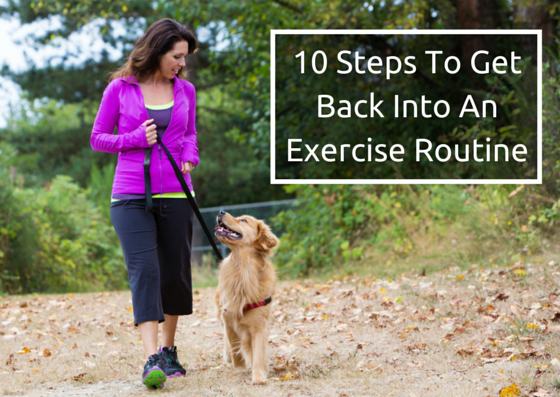Beginning an exercise routine after taking some time off can often be intimidating! Starting with baby steps and finding a routine you enjoy can help you stick to your plan and make great lifestyle changes to improve your health.
If you’re thinking about getting back into an exercise routine here are 10 tips for making sure you succeed:
1. Do it for yourself. 
Why exercise? Because it’s good for you! For every 10 lbs of weight you lose — you take 5 pounds of pressure off of a joint. The more you move the more your joints become lubricated, the stronger your muscles get, and the less physical pain you feel overall. Exercise has also been proven to improve your mood. So what are you waiting for? Start moving!
2. Start small.
You don’t have to join a gym, run a marathon or buy a lot of new exercise equipment to get back into an exercise routine. Start small. Just focus on putting one foot in front of the other and walk. Start by driving to a local high school or college track. Walk a quarter way around the track, or halfway if you can do so without any pain. Maybe a lap around the kitchen, living room or outside of your house is more reasonable.
Whatever you do, increase the amount and distance you move every day - even if it’s 5 minutes one day, and 10 minutes the next. Push yourself, but don’t hurt yourself. If you’re too sore, you’re less likely to keep doing what you’re doing.
3. Try something new.
If you’re doing the same thing every day, are you really challenging yourself to get to the next level? Probably not. Not only is it fun to try new things, there’s a good chance you’ll find something that motivates you to keep moving.
Even if you’re extremely overweight, or have never been athletic or coordinated, there are programs where you can do exercises while sitting in a chair, or standing in a swimming pool. Moving more is the key to getting to the next level of fitness.
4. Set realistic goals.
If you haven’t been active for a long time, don’t try to swim five laps the first time you get in the pool. If you start small, are consistent, and push yourself a little more each day in a few weeks or months you’ll be able to do things you can’t do today.
5. Change it up.
Just because you walk around the block five times every day doesn’t mean you have to do that all the time. Change up your routine. Walk around the local mall, or in the park instead of around the block. This helps you avoid boredom and keep moving.
6. Celebrate.
Don’t forget to celebrate each day you go a little farther and do a little more. Treat yourself to a baseball game, a hot bubble bath, take a motorcycle ride, or go to a movie when you reach a goal. Working out with a friend makes celebrating even more special.
7. Stick with it.
Science has proven it takes at least 21 to 30 days of repeating something to create a habit. So focus on moving some way for at least 15-to-30 minutes a day for 30 days. Keeping track of your progress is a great way to help you visualize the effort you're putting forth. Put an X on the calendar each day to reinforce your awareness and accountability.
8. Make exercise a ritual.
Plan ahead. Planning what you’re going to do every day is a big part of ensuring you will exercise. Make exercise a part of your to-do list or calendar to ensure you don’t forget or ignore it.
9. Exercise first thing in the morning.
If you exercise first thing in the morning you’re less likely to be tired or put it off. Find a good time in the morning and make it your time. Exercising at the same time every day also helps make exercise a ritual and a habit.
10. Don't get discouraged.
Every now and then you're going to have a crummy day. We all do. Don’t let one bad day derail your entire routine. Remind yourself that exercise is a long-term thing and that your experiences, good or bad, will vary from day-to-day. All the research over the past 10 to 15 years shows us that the more you move, the better you feel. Doing less is better than not exercising at all.
Learn More
Taking small steps with exercise each day can improve your health and help you live life you deserve.
If you're interested in learning more about some steps you can take to better your health, download our free white paper.
Our white paper covers both diet and exercise tops to help you make lifestyle changes for better health. Click the button below to download now and learn more.
Share This Post
Recent Posts
- The Relationship Between Obesity and Obstructive Sleep Apnea March 20 2015
- Cardiovascular Outcome Clinical Trials March 20 2015
- Diabetic Peripheral Neuropathic Pain March 20 2015
- Are All Types of Cholesterol Bad? March 20 2015
- Blood Pressure: The Highs, the Lows, and Everything in Between March 20 2015
Categories
- Clinical Trials
- Cardiovascular Disease
- Diabetes
- Obesity
- Kidney Disease
- Hypertension
- Pain Management
- Vaccine
- Cholesterol
- Chronic Obstructive Pulmonary Disease
- Diabetic Peripheral Neuropathy
- Migraine
- Osteoarthritis
- Biologics
- COVID-19
- Gastroesophageal Reflux Disease
- Irritable Bowel Syndrome with Constipation
- Lyme Disease
- Nonalcoholic Steatohepatitis
- Respiratory Syncytial Virus



